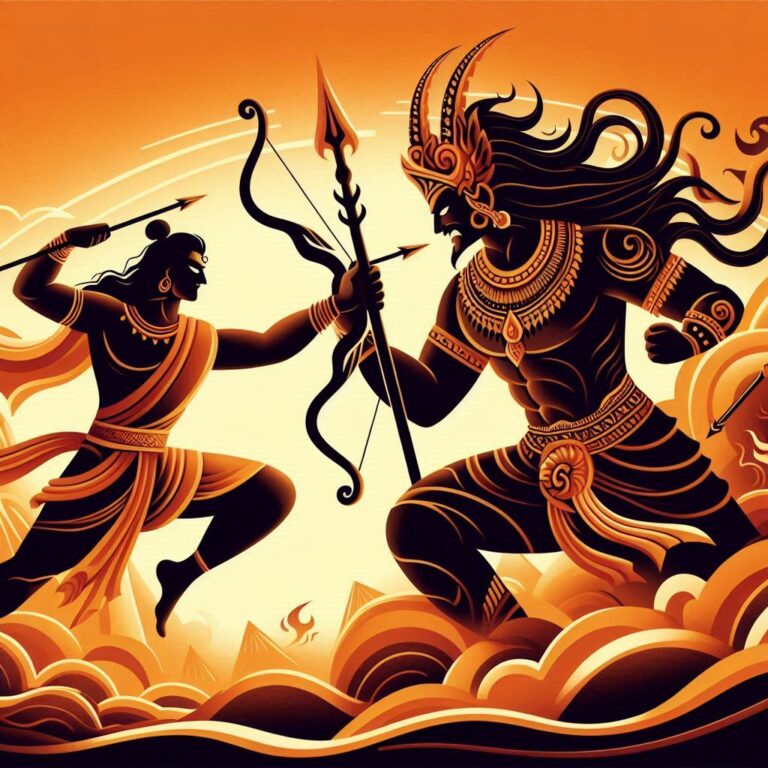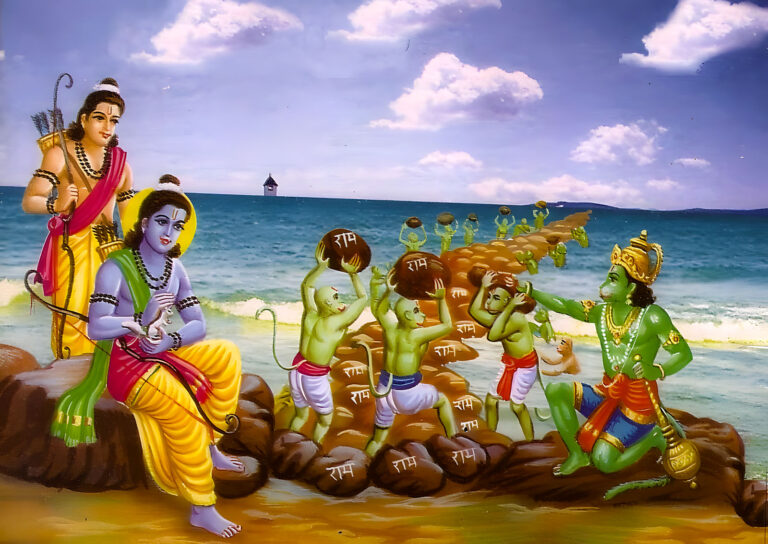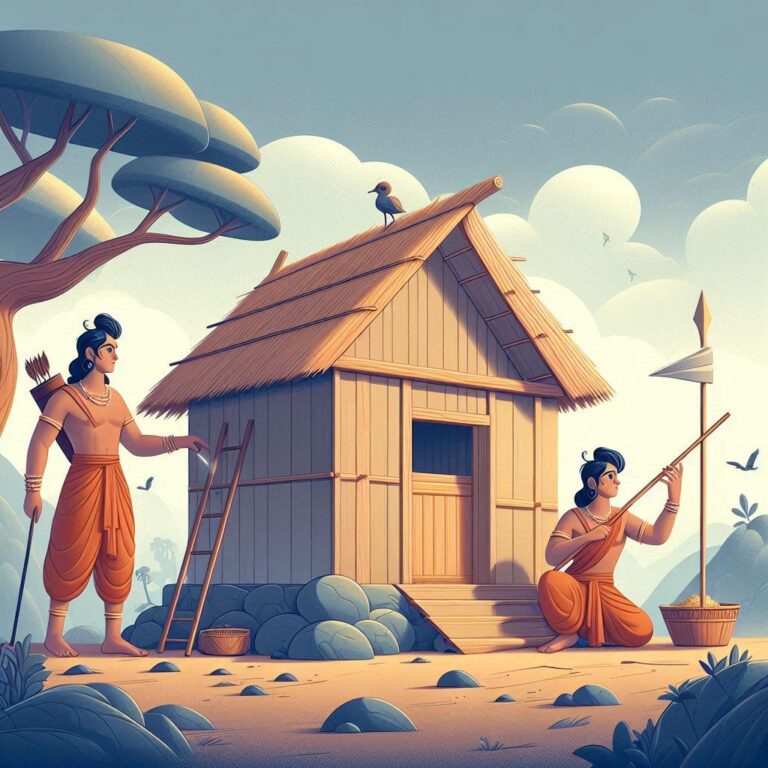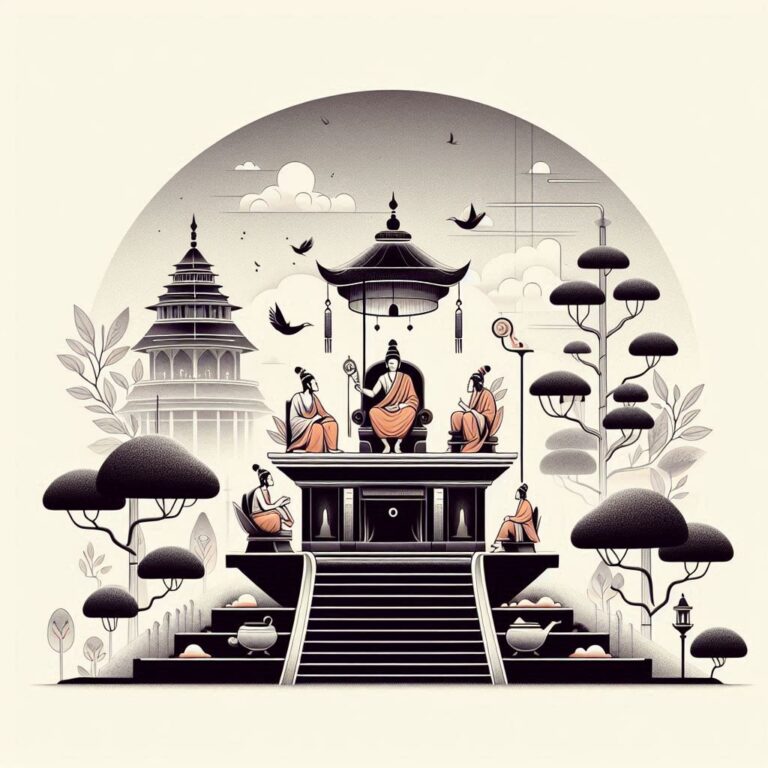The Sage’s Prayer for a Divine Hero
Introduction to the Concept of Divine Heroes
In the vast Hindu mythology, divine heroes occupy a revered place. These heroes, often incarnations of deities, are born to restore balance and uphold Dharma (righteousness) in times of crisis. The Ramayan, one of India’s most cherished epics, presents such a hero in the form of Lord Ram, an incarnation of Vishnu, who is called upon to defeat the malevolent forces of the demons (Rakshasas). The tale of how the sages, tormented by these demons, prayed for divine intervention, forms a crucial part of this narrative.
The Menace of Demons (Rakshasas)
The sages, who resided in the serene and secluded forests of Dandakaranya, dedicated their lives to performing rituals, offering prayers, and maintaining the spiritual fabric of the universe. However, their peace was shattered by the constant harassment of the Rakshasas, who took pleasure in disrupting their sacred ceremonies. These demons, embodiments of chaos and adharma (unrighteousness), sought to undermine the very foundations of the spiritual order.

The Sages’ Suffering
The suffering of the sages was profound. These learned men, who sought only to connect with the divine, found themselves unable to perform even the simplest of rituals without interference. The once peaceful Dandakaranya became a place of fear and despair, as the sages were relentlessly attacked by the Rakshasas. The demons desecrated their offerings, destroyed their hermitages, and even threatened their lives. This relentless torment led the sages to the realization that their plight could not be alleviated by mere human strength; they needed a divine hero to protect them.
The Need for a Divine Hero
Faced with the overwhelming power of the Rakshasas, the sages convened to seek a solution. It was clear to them that the only way to restore peace and order was through divine intervention. The sages, well-versed in the scriptures and the ways of Dharma, understood that the time had come for a divine being to incarnate and rid the world of this evil.
The Sages’ Collective Decision
The collective wisdom of the sages led them to the conclusion that only Vishnu, the preserver of the universe, could bring about the destruction of the Rakshasas. They knew that Vishnu, who had previously incarnated in various forms to restore balance, would once again descend to Earth to fulfill this purpose.
The Role of Dharma in Their Prayer
Dharma, the cosmic law that governs all existence, played a central role in the sages’ decision to pray for a divine hero. The sages understood that the Rakshasas represented adharma, a force that threatened the very fabric of the universe. By invoking Vishnu, they were not only seeking protection but also reaffirming their commitment to uphold Dharma.
The Prayer to the Divine
The sages, with hearts full of devotion and minds focused on their goal, began their prayer. They performed elaborate rituals and chanted powerful mantras, calling upon Vishnu to incarnate and save them from their tormentors. These rituals were not just acts of desperation; they were a reaffirmation of their faith in the divine order.
The Rituals and Mantras
The rituals performed by the sages were deeply symbolic. They involved the chanting of Vedic hymns, the offering of sacred substances into the fire, and the invocation of Vishnu through specific mantras. These mantras, rich in spiritual energy, were believed to have the power to compel the divine to intervene.

The Invocation of Vishnu
Among the many deities in the Hindu pantheon, Vishnu was the obvious choice for the sages’ prayers. As the preserver of the universe, Vishnu’s role was to maintain cosmic order and protect the righteous. The sages knew that Vishnu had taken various incarnations in the past to defeat evil and restore Dharma, and they were confident that he would do so again.
Shlokas and Dohas Related to the Prayer
The sages’ prayer for a divine hero is immortalized in the verses of the Ramayan. These shlokas and dohas capture the essence of their plea and the hope that their prayers would be answered.
Shlokas from the Ramayan
श्लोकः:
धर्मसंस्थापनार्थाय सम्भवामि युगे युगे ।
परित्राणाय साधूनां विनाशाय च दुष्कृताम् ॥
Phoenetics:
Dharmasaṃsthāpanārthāya sambhavāmi yuge yuge।
Paritrāṇāya sādhūnāṃ vināśāya ca duṣkṛtām॥
Translation:
For the establishment of Dharma, I incarnate in every age.
To protect the righteous and to destroy the wicked.
This shloka emphasizes the commitment of the divine to protect the righteous and eliminate evil. It reflects the hope of the sages that Vishnu would respond to their prayers by incarnating as a hero.
Dohas Reflecting the Sages’ Hope
दोहा:
साधु संगति सकल गुण खानी,
कुमति संगति बिनसे सयानी।
Phoenetics:
Sādhu saṃgati sakala guṇa khānī,
Kumati saṃgati binase sayānī।
Translation:
In the company of the good, all virtues flourish,
In the company of the wicked, even the wise perish.
This doha reflects the belief that the presence of the divine hero, the ultimate good, would not only protect the sages but also restore the virtues that had been lost due to the influence of the Rakshasas.
The Birth of the Divine Hero
The sages’ prayers were not in vain. Vishnu, moved by their devotion and the urgency of their plight, decided to incarnate as a human to rid the world of the Rakshasas. This incarnation would be none other than Ram, the hero of the Ramayan.
Vishnu’s Incarnation as Ram
Vishnu’s decision to incarnate as Ram was a pivotal moment in the cosmic narrative. Born into the royal family of the Raghu Dynasty, Ram was destined to become the protector of Dharma and the savior of the sages. His birth was a direct response to the prayers of the sages, symbolizing the power of faith and devotion.
The Role of the Raghu Dynasty
The choice of the Raghu Dynasty for Ram’s birth was significant. The dynasty, known for its adherence to Dharma and its noble lineage, provided the perfect environment for the birth of a divine hero. Ram’s connection to this lineage underscored the idea that divine intervention often works through established, righteous channels.
Ram’s Mission to Protect the Sages
From a young age, Ram was aware of his divine mission. His first major task was to protect the sages who had prayed for his birth. This mission took him deep into the forests, where he encountered and defeated numerous Rakshasas, fulfilling the promise made by Vishnu to the sages.
Ram’s Early Encounters with Demons
Ram’s first battles were against the demons that had terrorized the sages for so long. With his divine strength and unerring sense of Dharma, he was able to defeat them, bringing peace to the forests of Dandakaranya and allowing the sages to resume their rituals.
The Symbolism of Ram as a Protector
Ram’s role as the protector of the sages is rich in symbolism. He represents the divine force that upholds Dharma, and his battles against the Rakshasas symbolize the eternal struggle between good and evil. Ram’s victory is a testament to the power of righteousness and the inevitability of the triumph of good over evil.
Conclusion
The story of the sages’ prayer for a divine hero is a powerful reminder of the importance of faith, devotion, and Dharma. It highlights the role of divine intervention in restoring balance and protecting the righteous. The legacy of this prayer continues to inspire and guide those who seek to uphold Dharma in their own lives.
FAQs
What was the significance of the sages’ prayer in the Ramayan?
The sages’ prayer was significant because it led to the incarnation of Lord Ram, who was born to defeat the Rakshasas and restore Dharma.
Why did the sages choose Vishnu for their prayer?
The sages chose Vishnu because he is the preserver of the universe and had previously incarnated to protect the righteous and defeat evil.
How did Ram fulfill the sages’ plea for help?
Ram fulfilled the sages’ plea by incarnating as a human and defeating the Rakshasas who were tormenting them, thereby allowing them to resume their spiritual practices.
What is the importance of Dharma in the context of the sages’ prayer?
Dharma, or cosmic law, was central to the sages’ prayer. They believed that the Rakshasas represented adharma and that only a divine hero could restore balance.
How are the sages’ prayer and Ram’s mission connected to the broader themes of the Ramayan?
The sages’ prayer and Ram’s mission are connected to the broader themes of the Ramayan, including the triumph of good over evil, the importance of Dharma, and the role of divine intervention in human affairs.






